Are Single-Ply Wide Width Membrane Rolls Really a Benefit to Contractors?
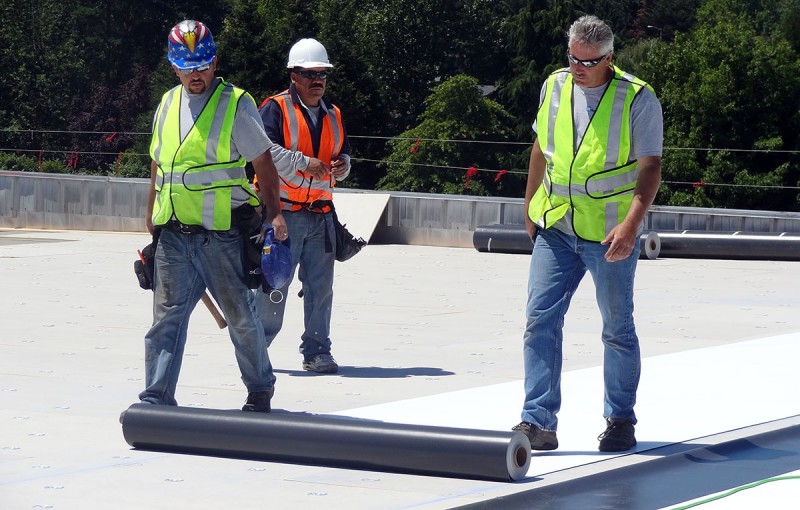
By Jason Stanley, CEO, IB Roof Systems.
As manufacturers compete to be the lowest cost producer, membrane rolls have grown in size, but at what cost to the contractor?
Do you ever wonder why restaurants promote a fresh fish special or catch of the day? It's often because they have too much product that will soon spoil if not sold. So ask yourself, is it really a "special" or is this just a clever way to move product to the benefit of the restaurant.
We see similar self-serving practices in a variety of forms in construction products, but none more than that of Single-Ply roofing like TPO and PVC. Traditionally, these products have been produced in rolls that are approximately 6 feet wide by 100 feet in length making the rolls around 200 lbs. As manufacturers compete to be the lowest cost producer, membrane rolls have grown in size. We’re now seeing membrane rolls at 10 and 12 feet wide by 100 feet in length weighing upwards of 450 lbs. The promotion and advertising support around these larger membrane rolls are that it is less expensive, faster to install and obviously better. But I would ask, "for who?!" and “at what cost?!”
There are economies of scale that benefit the manufacturers of wider products in production, storing and shipping, that in turn, are shown in sales materials, to be passed on to the contractor with stated labor savings of 40% fewer seams.
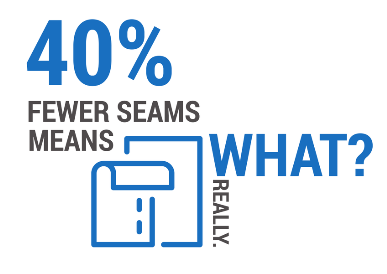
But in actuality, what we’re seeing are increasing frustrations from roofing contractors, when they find the difficulty of loading the material safely on the roof, positioning them in place, maneuvering around rooftop obstructions like A/C units and then fastening them to meet code requirements are left not only up to them but with the higher risk of job site injuries.
According to CNA, the country’s eighth largest commercial insurance writer and the sponsored insurer of the National Roofing Contractors Association, back and other related physical injuries are increasing in surprising rates. A Minnesota University study found that “the most common activity associated with low-back pain are those jobs requiring lifting and forceful movements.” Furthermore, this study found that “low-back disorders account for almost 30% of injuries, requiring time away from work.
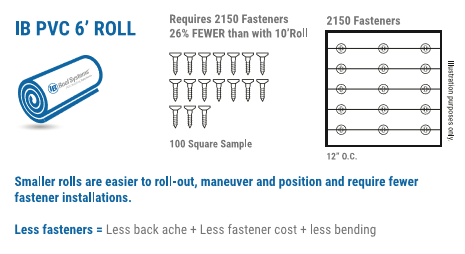
Its estimated economic impact in lost productivity, health-care related expenses, and disability are staggering. The average cost of a low-back associated workers compensation claim is nearly $8,500. This is double the cost of the average injury claim.”
Three questions arise when considering wider membrane rolls -- How much faster? How much cheaper? And for who? When contractors are being told ‘40% fewer welded seams’, this would appear to show a faster installation rate and lower labor costs. But with wider rolls and the dramatic increase in weight the sum of the savings promised are not being realized in the data contractors are showcasing.
Fewer seams would logically project 40% fewer plates, 40% fewer fasteners and labor. While it appears logical it isn’t that simple. On actual project reports from contractors, the amount of fasteners being used is actually creating a time loss due to reduced fastening spacing guidelines being required when wider rolls are utilized. Let’s take for example 6 foot and 10 foot wide rolls on a 100 square roof (100’ x 100’ or 10,000 sq ft). The 6 foot wide rolls require 2,150 fasteners versus the 2,912 fasteners required on 10 foot wide rolls.

To be clear, we’re talking about an approximate two-hour time difference overall on the installation of those fasteners. What contractors aren’t being told to consider is the inherent risk of injury between bending and fastening versus walking a hot air welder.
For higher wind zones, contractors are, in addition, being required to install a row of fasteners or fasten a termination bar down the middle of each sheet, then a 6” cover strip is required to be welded over them. When this is the case, the amount of welded seams for the wider sheet has not lessened, but increased by one versus the traditional 6 foot wide sheets. Not to mention when using a termination bar and additional welded seams – you create roof area that is prone to water ponding. Water ponding is an entirely separate issue and we can go down that road another time.
The second point is in the reduction of labor savings in actual installations. Comparing again the 6 foot and 10 foot wide rolls on a 100 square roof (100' x 100' or 10,000 sq ft).
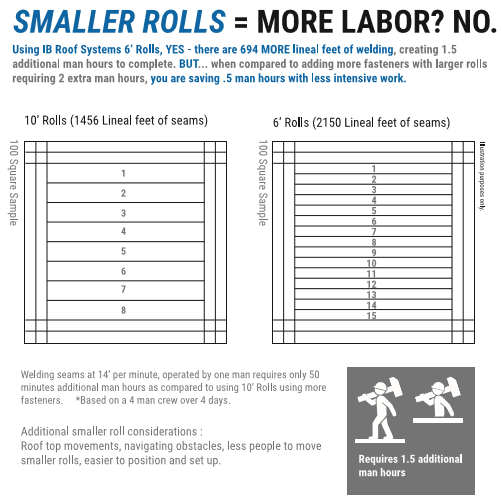
The 6-foot-wide roll has approximately 2,150 linear feet of seams while the 10-foot wide roll has 1,456 linear feet of seams. With this on the menu, it may have you thinking, “Fish sounds pretty good, maybe I do want today’s special?” But reading further you find that your favorite, ‘go to’, meal has more value.
Commercial roofing projects such as these are welded with a robotic welder that moves at a rate of about 14 feet per minute and is operated by just one man, the additional 700 feet of robotic welding takes one man an extra fifty minutes to complete. In a different perspective, a project of this size, assuming the installation of a common roof assembly made up of 2 layers of insulation and a cover-board with a minimal amount of rooftop details and drains would typically require a crew of 4 men approximately 4 days to complete, totaling 128 man hours. In looking at the details, it takes longer to install the fasteners on the 10-foot wide roll versus the 6 foot wide rolls, therefore, creating minimal, if any, labor savings. So again, I ask, ‘Where is the savings?’
While most people will accept some trade-offs to gain efficiency this one has additional significant impacts on the health and safety of roofing contractors that have to manhandle heavier rolls on job sites all across the country. This indicates that the actual benefit to the contractor, if any, is negligible.
In conclusion, roofing manufacturers should change focus from being manufacturing-centric to being contractor-centric and produce products that benefit the men and women that labor to install these products. The wider, heavier and more injury prone rolls don't seem very "special" and smell more like "the fish of the day." I think I will have the bacon burger after all.
What’s in it for the contractor? EVERYTHING! Visit www.ibroof.com/makemore
Stats from CDC on max lifting weights: https://www.cdc.gov/niosh/docs/94-110/pdfs/94-110.pdf
Worker Comp Claims on lifting: http://www.injuryclaimcoach.com/lifting-injuries.html








-2.png)



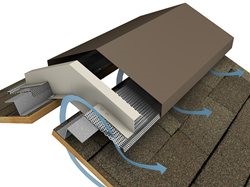

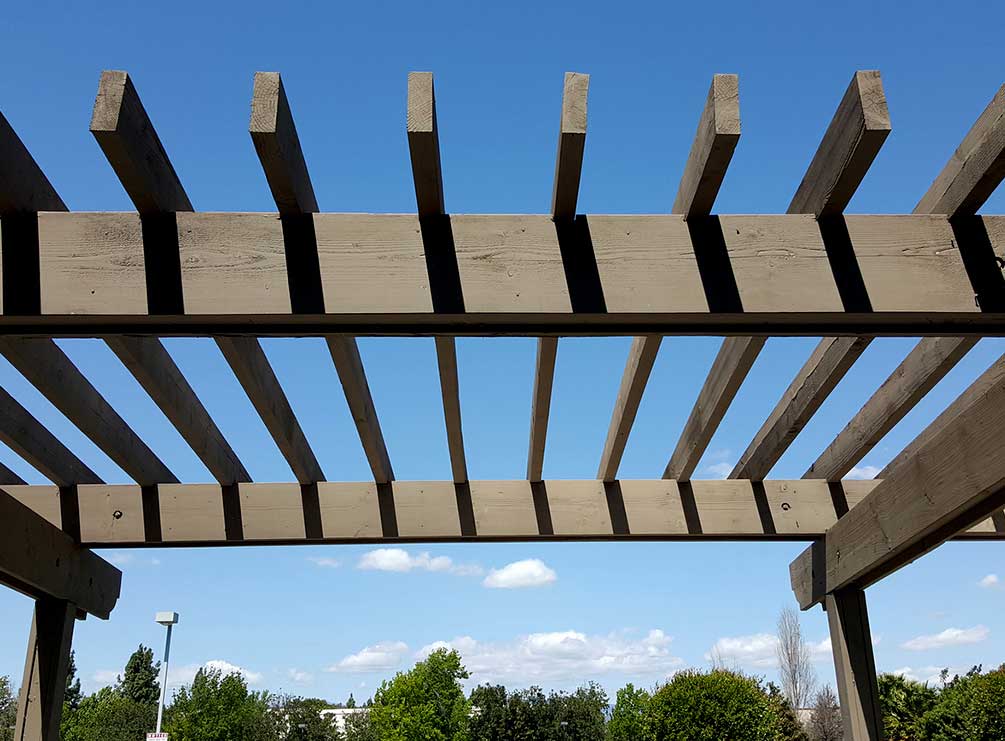




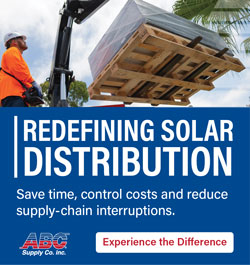

Comments
Leave a Reply
Have an account? Login to leave a comment!
Sign In